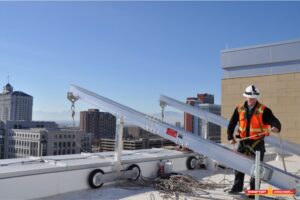Slips, trips, and falls continue to be one of the leading causes of occupational injuries and deaths. In a 2022 report published by the National Safety Council (NSC), approximately 20% of the 4,530,000 occupational injuries that required medical attention were falls. Since 2009, the number of fatal falls has only increased each year, with an exception in 2020 when many businesses shut down during the early months of the COVID-19 pandemic.
The last decade and a half have seen 800-900 people die annually from fall incidents. At the same time, fall protection manufacturers and safety equipment vendors have only increased their presence in facilities and job sites to train workers on the gravity (no pun intended) of fall hazards and the danger present. So why then is the number of falls failing to decrease year after year? There seems to be some consensus among safety professionals that worker complacency is a growing concern and one that is extremely difficult to mitigate. Signs of complacency can often go unnoticed until they begin to affect productivity and safety. Employers must identify these signs and understand their potential consequences.
The consequences of complacency
Complacency is a state where employees become comfortable in the tasks they’re performing and grow an indifference towards safety protocols and procedures. This behavior can lead to accidents and injuries, affect job performance, and impact team morale. Workers want to be productive at their work and can sometimes view safety procedures as excessive, unnecessary, or an obstacle in completing their tasks. This is extremely common in facilities where an accident hasn’t occurred lately. While a low number of injuries is typically a positive metric for a business, it does not necessarily mean that near misses are not simultaneously occurring. Safety programs should have mechanisms in place for workers to report near misses or address safety concerns, and to reward those workers for reporting them.
Complacency can also cut into a business’s bottom line. According to the NSC, falls are the third highest worker’s compensation claim with an average of $50,000 per claim. Depending on the nature of the fall that occurs, other direct costs can be OSHA penalty fines, litigation fees, and downtime due to the incident. The indirect costs of a fall can add up quickly as well, including decreased worker productivity due to lowered morale, employee turnover can increase following a major incident and lost business from a damaged reputation. Some sources estimate that the indirect costs can often be up to four times greater than direct costs.
How to combat complacency
As mentioned earlier, safety leadership can help foster a more positive safety culture by rewarding employees for identifying safety concerns or reporting near misses as they occur. For more people to get involved in enhancing a facility’s safety over time, there must be incentives in place to encourage participation. Some employers have had success implementing “safety ambassadors” among work crews that can increase user compliance and give interested workers more ownership over their team’s safety. Often, workers are more likely to heed safety advice from one of their peers who is more familiar with the work being performed, as opposed to someone in management who rarely performs the task on a regular basis.
Fall protection awareness training can also be an effective method to combat worker complacency. Often, complacency grows from a place of ignorance where workers are simply not aware of their exposed risks. Employers should be sure to communicate policies that prioritize worker safety over worker productivity. From a financial perspective, it is much less expensive to invest in worker safety than it is to hire, replace, and train new workers taking the place of those out temporarily due to injury or permanently due to fatality. Some organizations have found it effective to invite speakers who will give a first-hand account of how fall protection or the lack thereof has impacted them.
If time or budgets are thin and increased internal training might be infeasible, organizations should talk to their existing fall protection partners for complimentary training or resources they will provide. It’s extremely common for fall protection manufacturers to offer their representatives to visit facilities to connect with workers, assess their facility for fall hazards, and then train those workers on how to work as safely as possible. Those representatives can then propose solutions and help the organization navigate ways to implement them.
The consequences of worker complacency can be severe, including consequences such as an increase in workplace accidents or a drop in overall performance. Employers can counter this by implementing effective training programs, fostering a positive work culture, and providing regular recognition to employees who contribute.
Companies who invest in safety programs see many benefits besides safer working conditions for its workforce. They also see increases in worker productivity, loyalty, and improved company morale. Many hands can make light work. When it comes to combating complacency, we need all hands-on deck. Companies like Diversified Fall Protection have helped many businesses train their employees and help build a more robust safety culture. Their nationwide network of regional fall protection specialists can provide valuable insight, years of earned industry experience, and proven customer solutions to help elevate your fall protection program and get your site OSHA-compliant.
Philip Jacklin is Continuing Education Program Manager for Diversified Fall Protection. He is an AIA continuing ed provider, QSSP & OSHA-30 certified, and has been a partner to the fall protection industry since 2018.

